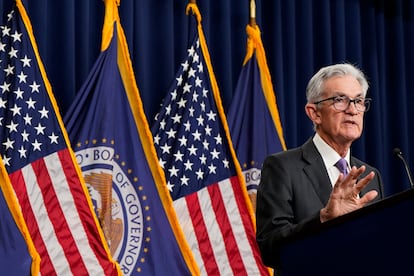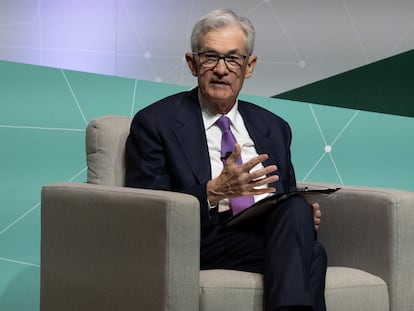Could the Fed end up raising rates this year?
That possibility did not even exist a couple of weeks ago, but now it is considered a real risk by some analysts. The market is now questioning the central bank’s prediction of three cuts in 2024

Expectations that the Federal Reserve will lower interest rates are getting lower with every passing day. Enthusiasm about the possibility was seriously curbed last week with the release of new data that shows persistently high inflation levels incompatible with lowering the price of money. And the week is off to a bad start with looming threats of rising oil prices due to the escalating conflict in the Middle East, which is being followed with growing concern by central banks. Rates in the world’s biggest economy are predicted to drop by considerably less than what was expected at the beginning of the fiscal year. And the possibility of the Fed actually raising them again is no longer a completely unlikely scenario. Some analysts are even including that option as a real risk in their forecasts. Since March 2022, the U.S. central bank has raised its policy rate by 525 basis points to the current 5.25%-5.50% range.
The market’s base case is for two rate cuts until January, down from the three that the Fed itself suggested for 2024 at its March meeting. The biggest likelihood of a cut for 2024 was focused on the December meeting, after the presidential election, rather than in September. But the picture has changed since last Friday — before Iran’s attack on Israel — when the market felt there was a 48% chance that there would be a rate cut in September. On Monday, that percentage had declined to 38%, clearly reflecting investor doubts.
Investor confidence in Fed cuts has declined significantly since December, when the market was betting on anywhere between six and seven interest rate cuts during 2024. The U.S. economy has proven remarkably resilient and inflation is failing to decline, both of which are modifying analysts’ and investors’ opinions in a way that would have been unthinkable just a few days ago. “If the higher inflation data persist, we estimate that the probability of a rate hike this year will go up to 10-15%,” said Geir Lode, Head of Global Equities at the financial firm Federated Hermes. While this is still a low number, it has been making headway this month in the wake of the release of various economic indicators.
On March 1, a survey by the Institute for Supply Management showed much better manufacturing data than expected, leading to expansion for the first time since September 2022. Bond yields began to improve, and futures markets started betting on a slight rate hike for the first time in months. The strength of the U.S. economy was further confirmed by job data from March, when 303,000 new non-agricultural jobs were created, far more than the 214,000 that had been expected. However, the data point that truly reverted rate cut expectations for this year was last week’s publication of the March Consumer Price Index, which shows that consumer prices rose at a pace of 3.5% for the 12 months ended in March, with underlying inflation at 3.8%, still far from the 2% goal of the Fed’s monetary policy. This most recent data rules out an interest rate cut in June, said Geir Lode. Following the release of the inflation data, Goldman Sachs reduced its estimate of three cuts this year down to two.
The escalating tension between Israel and Iran is contributing to investor forecasts about just two rate cuts this year. However, Iran’s attack, in retaliation over Israel’s previous attack on the Iranian consulate in Damascus, did not cause any significant damage and the markets on Monday did not seem to think there would be an escalation of the conflict, with the price of crude actually dropping. Analysts at Citi did not see the likelihood of a barrel hitting the $100 mark, which could have an impact on monetary policy.
“It’s not very likely that there will be a great inflationary shock or that the upward trend will return. As a result, we would characterize the current dynamic as a delay in reaching inflationary goals, rather than a complete elimination of the downward trend,” says Felipe Villarroel, a partner and manager at TwentyFour. However, this expert admits that the probability of a hard landing for the U.S. economy would increase if inflation data prevent the Fed from starting to cut rates. His advice is to “have some liquidity to be able to react to a change in the base case.”
Sign up for our weekly newsletter to get more English-language news coverage from EL PAÍS USA Edition
Tu suscripción se está usando en otro dispositivo
¿Quieres añadir otro usuario a tu suscripción?
Si continúas leyendo en este dispositivo, no se podrá leer en el otro.
FlechaTu suscripción se está usando en otro dispositivo y solo puedes acceder a EL PAÍS desde un dispositivo a la vez.
Si quieres compartir tu cuenta, cambia tu suscripción a la modalidad Premium, así podrás añadir otro usuario. Cada uno accederá con su propia cuenta de email, lo que os permitirá personalizar vuestra experiencia en EL PAÍS.
¿Tienes una suscripción de empresa? Accede aquí para contratar más cuentas.
En el caso de no saber quién está usando tu cuenta, te recomendamos cambiar tu contraseña aquí.
Si decides continuar compartiendo tu cuenta, este mensaje se mostrará en tu dispositivo y en el de la otra persona que está usando tu cuenta de forma indefinida, afectando a tu experiencia de lectura. Puedes consultar aquí los términos y condiciones de la suscripción digital.
More information
Archived In
Últimas noticias
Most viewed
- Sinaloa Cartel war is taking its toll on Los Chapitos
- Oona Chaplin: ‘I told James Cameron that I was living in a treehouse and starting a permaculture project with a friend’
- Reinhard Genzel, Nobel laureate in physics: ‘One-minute videos will never give you the truth’
- Why the price of coffee has skyrocketed: from Brazilian plantations to specialty coffee houses
- Silver prices are going crazy: This is what’s fueling the rally











































